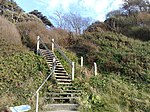Needles Lighthouse
Buildings and structures on the Isle of WightGrade II listed buildings on the Isle of WightGrade II listed lighthousesLighthouses completed in 1859Lighthouses in England ... and 3 more
Lighthouses of the English ChannelTrinity HouseUse British English from August 2017

The Needles Lighthouse is an active 19th century lighthouse on the outermost of the chalk rocks at The Needles on the Isle of Wight in the United Kingdom, near sea level. Designed by James Walker, for Trinity House at a cost of £20,000, it was completed in 1859 from granite blocks. It stands 33.25 metres (109.1 ft) high and is a circular tower with straight sides. It replaced an earlier light tower on top of a cliff overhanging Scratchell's Bay, which was first lit on 29 September 1786.
Excerpt from the Wikipedia article Needles Lighthouse (License: CC BY-SA 3.0, Authors, Images).Needles Lighthouse
T25,
Geographical coordinates (GPS) Address External links Nearby Places Show on map
Geographical coordinates (GPS)
| Latitude | Longitude |
|---|---|
| N 50.662277777778 ° | E -1.5918055555556 ° |
Address
The Needles Lighthouse
T25
PO39 0JD
England, United Kingdom
Open on Google Maps










